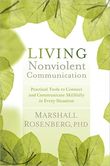By Marshall Rosenberg, PhD
Sounds True, $19.95, 170 pages
We all have feelings and needs. When our needs are met we are glad, hopeful, trustful, optimistic, and when they are not met we feel bad, sad, angry, and hopeless. Sometimes people turn to violence while trying to fulfill their needs. Marshall Rosenberg is convinced that people behave violently only because they have been educated in this way. In Living Nonviolent Communication, he teaches skills that in his opinion allow to everyone meet their needs. Rosenberg’s nonviolent model of communications, in which empathy plays a very important role, provides powerful tactics for resolving difficult situations peacefully.
“…we do not look for compromise; rather, we seek to resolve the conflict to everyone’s complete satisfaction.”
However, some of the transcribed workshop’s dialogues sound artificial and a number of statements and strategies are controversial. For example, would you agree with Rosenberg that “killing people is too superficial” and use of reward isn’t better than of punishment? It is interesting to find out how Rosenberg argues such issues and why anger is a valuable asset in Nonviolent Communication. Although the necessity of empathizing with people who hurt us could be difficult for many people, Rosenberg reasons that this is the right way and everyone has to learn how to openly communicate his or her feelings and needs without sounding critical, offensive, demanding, or threatening, to satisfactorily resolve any conflict.
Reviewed By Galinia Roizman
[amazon asin=1604077875&text=Buy On Amazon]
[amazon asin=1604077875&text=Buy On Amazon&template=carousel]

